|
"The difference between the hsing-i I passed on to you and what I taught military
officers during the war is significant. You learned more and had more time to
perfect the art."
It was 1988. The person speaking, was my teacher Col. Chang Hsiang Wu. His statement,
made in response to a question I asked about the Chinese army's use of hsing-i
during the Second World War took me completely by surprise.
I had recently been contracted to teach close combat to army reconnaissance
instructors. Col. Chang and his wife Major Chang Yen Ying (a senior student
of Du Shen Wu and former close combat instructor for the Chinese commandos)
were giving me advice on how to structure the program. During the conversation
Col. Chang began sharing some of his thoughts and experiences as they related
to his hsing-i tenure in the military. He also, to my delight, expanded upon
aspects of strategy (both in combat and training) that make hsing-i such an
effective system.
Known primarily as an empty hand system, hsing-i does in fact utilize several
traditional weapons. Its reputation as a deadly fighting art was so widely respected
that in the 1920's and 1930's, its armed and unarmed methods were adopted into
many Chinese military training programs. Masters such as Sun Lu Tang; Wang Hsiang
Chai and Huang Po-Nien all contributed to the military use of hsing-i. Probably
the most prestigious military group to train in hsing-i was the Central Military
Academy of China at Nanjing. Their chief hsing-i instructor was my teacher,
Colonel Chang Hsiang Wu.
In addition to empty hand skills, the military frequently placed emphasis on
traditional weapons such as sword and spear. However, in keeping with the modernization
of the Chinese army, these weapon skills were adapted for use with more contemporary
counterparts. Rifle and bayonet replaced short spear. Traditional saber and
sword forms were transposed for use with either a one or two handed Western
style cavalry or infantry officer's sword.
The first thing Col. Chang did was to clarify his opening comment to me. He
explained that when preparing for war, training is accelerated. At Nanjing,
the "bare hand" or "empty hand" techniques were taught in three stages over
a period of one or two months. These stages, in order of training, were: forms
and basics; applications/ prearranged sparring and; free fighting. (Hsing-i
rifle and bayonet techniques in other branches of the army follow the same training
format but were divided into four stages.) Not all hsing-i forms were taught.
Because of limited time, emphasis was placed solely upon understanding the five
fists; two man and linking form; and their practical application. Why? Because
these movements form the foundation of hsing-i. It is through a strong understanding
of these basics that one is able to transform a single strike into a killing
blow. It is also from these same basics that all weapons' applications evolve.
As is the case in all military training, development of the group takes precedence
over development of the individual. This may be contrary to our notion in martial
arts of "perfection of self" but it is in perfect keeping with conditions found
in war or military operations. All officers were expected to obtain the same
high-level of proficiency at the same rate as their classmates. Training was
particularly demanding as survival and success in battle was predicated upon
each man being able to "hold his own". One weak link in the chain would result
in failure and death. Those that fell behind, "suffered the consequences" or
in Col. Chang's ominous words "they kept up or else". (He refrained from elaborating
on what "or else" entailed. He did however emphasize that full-contact free
fighting was part of the training.)
Colonel Chang was quick to point out that although hsing-i training was condensed,
it none-the- less followed the "orthodox"method of instruction. Some contemporaries
of Col. Chang (such as Wang Hsiang Chai) who taught in other branches of the
army first broke the fist instruction down into three parts. Standing post (meditation);
stances and stepping; and hand techniques were all taught separately. Only later
were they recombined into their complete forms. At the Central Military Academy
the fists were all taught as complete actions. (Which incidentally, is the manner
in which I received my instruction.) This allowed the officer to quickly develop
a proper sense of timing, weight shifting, and stability, thereby accelerating
his learning process. Colonel Chang did not deride Wang and others like him
for their segmented approach to teaching the end result was more or less the
same. However, given the time restraint, learning all movements together was
faster and better served the military and the soldier's purpose.
The advantage a military art like hsing-i has over many other martial arts is
that it is deceptively simple in execution (if not in concept) and direct. Additionally
it follows what is often referred to as a "uniform theory" approach to training.
At its simplest level, "uniform theory" allows for the direct transference of
basic technique from one weapon (including empty hand) to another.
When discussing the use of a weapon, most martial artists recite the adage "a
weapon is simply an extension of the body". This statement is only partially
correct. If for example, your arm was as long as a spear (extension of the body)
you still could not cut or penetrate your opponent as a real spear would. Therefore
a more complete rendering of the principle should read: " in addition to being
an extension of the body each weapon also has its own unique characteristics".
In the case of the spear cutting and thrusting. In the case of the sword chopping
and thrusting. Weapons also differ in length and weight. A double-edged dagger
has the same blade characteristics as a sword. However, because of its shorter
length the person using it has less reach. Additionally, its light weight significantly
reduces its effectiveness as a chopping weapon. Uniform theory takes all this
into account and utilizes a natural training progression to teach how to use
body mechanics to maximize efficiency when employing any weapon.
Paralleling this is a natural progression for learning strategy of combat. This
strategy makes the characteristics of any weapon immediately apparent and easily
utilized. Additionally, this same strategy identifies the body's natural responses/tendencies
(even in trained adversaries) and clearly shows the soldier how to exploit them
to his advantage. (Col. Chang's other duty at the Academy was military strategy
instructor. He taught officers how to apply the lessons of Sun Tzu to both large
scale military and guerrilla warfare operations.)
In combat, it has been proven that soldiers only recall and utilize the simplest
things they have been taught. High stress and physical/mental fatigue are the
main contributing factors to disruption of the thought process and failure to
respond in the optimum (or even correct) manner. Western military close combat
systems are, by comparison to the Chinese, lax in dealing with this reality.
There are many reasons why this is the case. More often than not it is because
each phase of Western close combat training (e.g. empty hand; rifle and bayonet;
etc.) has its own theory and manner for applying techniques. This results in
several theories having to be recalled and employed in a combat situation not
too realistic if we consider the need for split-second decisions in the heat
of battle. Additionally a soldier may have to employ an improvised weapon not
covered in close combat training (e.g. a ration tin or shoe lace). How does
he deal with this type of dilemma? A study of over 1,000 documented cases of
of close combat in the Vietnam conflict revealed that soldiers in these situations
did not, as a whole, respond in a manner they expected or were trained to. An
overriding factor was the "confusion" created by trying to recall or decide
which "appropriate" course of action (read: theory) should be applied. Had they
been able to rely on a few easily understood and translatable principles, the
outcome (or at least the course of action) in many of these confrontations may
have been different.
So why was hsing-i more "appropriate" than other martial arts for the war China
was about to engage in ? Well according to Col. Chang there were several reasons:
The first and most obvious reason is that lethal close combat skills were actually
needed. Modern military units (especially in the West) tend to rely on superior
weaponry and fire power over "empty hand" or close combat fighting ability.
Since the Chinese were usually poorly equipped they had to make up for their
deficiencies in other ways. One of the ways was through the use of combat proven,
lethal martial arts. Hsing-i was such an art. Another was through employing
the military strategy of Sun Tzu. Bing fa and their manner of close fighting
served the Chinese army well in the past and continues to do so even now in
the present.
The second reason is the realization that war with Japan would occur on both
a physical and spiritual level. Not only was Japan a modern and well-equipped
military force, but it was also driven by their fierce spirit of bushido. China
on the other hand subscribed to the Confucian precept of "jen i chih tao" the
spirit of benevolent righteousness or more simply, the concept of the righteous
man or hero. This concept was seen by the Chinese as being on a higher spiritual
plane than that of bushido. Hsing-i helped to reinforce this Chinese idea through
the use of the five element theory as it relates to the five "fists" of hsing-i.
Historically, the five element theory can be traced back to the Shang dynasty.
One of its uses in hsing-i is as a means of teaching rudiments of strategy.
Each fist corresponds to an element. Each element, according to the theory,
is assisted or hindered by another element/fist. By applying these combinations
in practice the fundamentals of attack and defense are established. Through
their teaching of the five element theory instructors were able to accomplish
two goals. The first is the establishment of a simple yet efficient combat strategy.
The second, is the forging of a cultural/spiritual link between the modern Chinese
infantry officer and the righteous warriors of ancient times. (Note: Achievement
of the second goal was assisted by the physical introduction of hsing-i considered
by many Chinese as an "ancient or legendary" martial art; into the realm of
modern warfare.)
The third reason is the manner in which the fist forms are practiced and implemented.
Initially, there are no backward /withdrawing movements. This is ideal for the
military because it instills in the soldier the idea of aggressive attack. Forward
movement also allows the soldier to close distance and move inside an opponent's
effective fighting range. While of valuable use against a knife or short sword
it is of particular advantage when dealing with a long weapon such as rifle
and bayonet. (It is important that the reader understand the strategic difference
between retreating and withdrawing. When retreating, your intention is simply
to get away. The problem: It is difficult to defend and retreat at the same
time. Withdrawing on the other hand means moving back while maintaining your
defensive position. In hsing-i withdrawal is performed either to draw the opponent
forward while setting him up for a counterattack or; to give yourself additional
room to maneuver before delivering your counterattack. Hsing-i considers such
withdrawal techniques secondary and concentrates on closing distance to inhibit
the opponent's movement. Hsing-i does however, place emphasis on always moving
from one protected position to another regardless of whether you are advancing
or withdrawing.)
In addition to moving forward all five element techniques utilize continuous
flowing and alternating actions. These assist the practitioner in several ways:
1. Continuous flowing enables you to incorporate your body mass while delivering
the blow. For example in empty hand p'i ch'uan, momentum of the body generated
in the counter-strike is capable of breaking your opponent's neck. In the saber
technique of p'i ch'uan, the chopping and cutting actions of the sword are made
more devastating by dropping the weight of the shoulders and arms. The result
is a cut that penetrates all the way to the bone. Such a cut causes severe nerve/muscle
damage; massive trauma/shock and; most likely death.
2. Continuous flowing allows combatants to move easily and steadily over uneven
terrain. Steps are kept low and reinforced so that there is no over-extension.
The two- fold end result is an ability to change both level and angle of attack
and an ability to deliver a killing blow or at the very least, several crippling
blows in quick succession. (On the battlefield techniques requiring several
moves to simply "take down" an opponent are virtually useless.)
To understand how the "uniform theory" is applied consider the following examples:
Example #1 (P'i ch'uan empty hand method)
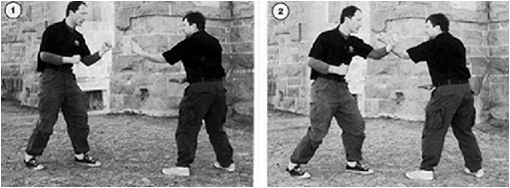 |
In
this example, the attacker executes a straight punch to your sternum. (Figure
1) You respond by directing the punch past your body using your lead arm (Figures
2 & 3). You immediately close distance and deliver the counter to the opponent's
head (Figure 4). Momentum generated here by your body mass is actually transmitted
through your arm to the base of your opponent's skull creating a whiplash effect.
If successfully employed, a follow-up technique becomes redundant!
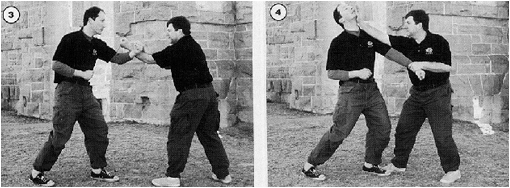
Example #2: (P'i ch'uan bayonet against bayonet.)
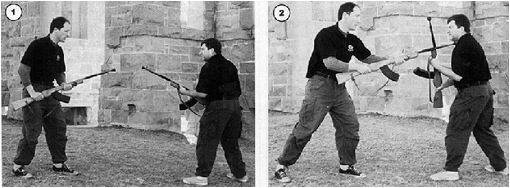
In this example the opponent lunges at your chest with a rifle and bayonet. You
respond by using the barrel of the rifle to direct his weapon past your body.
You immediately step inside his range and slash downward with the cutting edge
of the bayonet. (In example #2 and #3 the deflection is accomplished by simply
moving the point of your weapon to your rear. Do not attempt to "knock" or smash
the opponent's weapon away.)
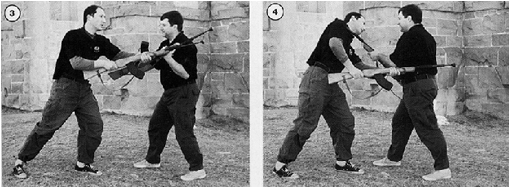
Example #3: (P'ao ch'uan empty hand against knife method.)

In the first instance you are "empty handed". (Figure 1) As your opponent thrusts
to your head, you step straight in (angled towards the opponent). Use the rising
block portion of your movement to strike his arm. The angle of the block (greater
than 90 degrees) will cause his weapon to deflect to your side and past you. If
you strike him either above or below the joint of the elbow the resulting blow
will cause his arm to hyper-extend. (Figure 2) Immediately follow the block with
the punch to his rib cage. (Figure 3) (Both your block and punch occur almost
simultaneously.)
Example #4: (P'ao ch'uan knife against knife method.)

In the armed version of p'ao ch'uan, you perform exactly the same movements. However,
in this case your right (blocking) hand holds a knife or bayonet in reverse grip
(Figure 1) cutting the opponent as you block . (Figure 2) Once the punch has been
delivered, (Figure 3) you step in and use the knife for the finishing technique.
(Figure 4)
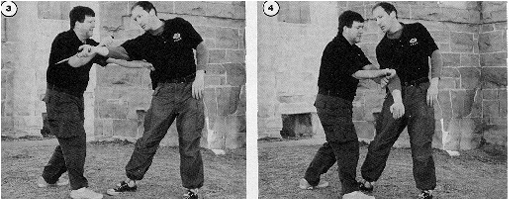
With the exception of few minor variations, all of the fist forms reflect a continuity
similar to those depicted in the preceding example. Stance, reinforced stepping,
use of body weight and mechanical efficiency all follow the principles of the
uniform theory. Flowing action and closing distance round this out by helping
to render the opponent incapable of defense.
As we prepared to part company, Col. Chang gave me one solid piece of advice.
"Remember," he said, "the fight is always the fight for your life. If your life
is not threatened, then no fight is necessary. If your life is in danger, you
must do what is necessary to survive." Having studied with him for so many years
I immediately understood the importance of the statement and agreed. I also knew
in my heart that the difference in my hsing-i training really had been significant.
|

